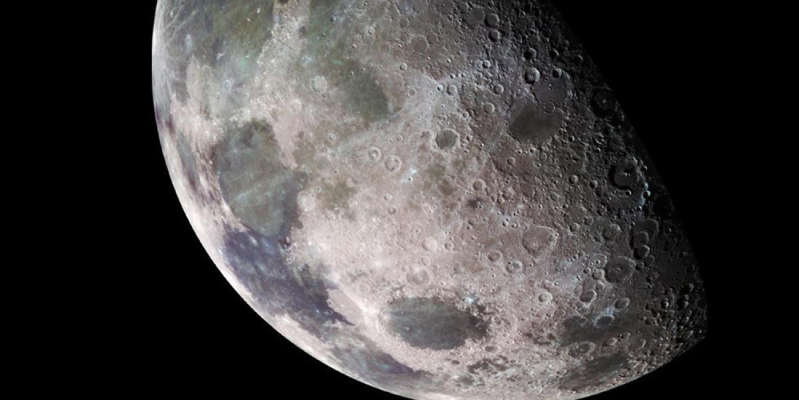
The history of the development of a natural satellite: 45 years ago the Luna-24 station was launched
Is there water on the moon? To answer this question 45 years ago, the automatic interplanetary station “Luna-24” was launched from the Baikonur cosmodrome. Two weeks later, the device delivered a soil sample to Earth, in which scientists found H2O molecules. Anna Bazhaikina, the correspondent of MIR 24, learned why further studies of the Earth's satellite were stopped for many years.
“This is how the lunar soil looks like, delivered by Soviet automatic stations from the surface of the moon.”
There are only four grams under the museum glass. But in the lunar race of the 20th century, even such a portion is worth its weight in gold. Americans in 69 were one step ahead. We set foot on the lunar surface and dug up 21 kilograms of soil there.
In 1970, the Soviet Union sent the Luna-16 apparatus for lunar soil. A little later, another one. And so, by 1976, they prepared “Luna-24” – a station with a drilling rig.
The robot drilled a little more than one and a half meters of the surface and delivered 170 grams of lunar soil.
“At our institute, reception rooms, receiving chambers were built, boxes made of stainless steel, made of organic glass, isolated from the atmosphere, were developed, which made it possible to operate with samples in an atmosphere of an inert helium gas that does not react with matter,” said a senior researcher at the Meteoritics Laboratory Institute of Geochemistry and Analytical Chemistry, Russian Academy of Sciences Kirill Lorentz.
The history of the development of a natural satellite: 45 years ago the Luna-24 station was launched

WORLD 24 More videos SHARE Tweet SHARE SHARE MAIL What else to see
-

Dual contamination: what happens in the body when multiple strains of COVID-19 are detected?

WORLD 24
-

Vaccination against COVID-19 for children: the pediatrician told the details

WORLD 24
-

A new global threat: where can you get monkeypox?

WORLD 24
-

70 years ago, the first space flight with dogs took place

WORLD 24
-

Multipurpose laboratory module “Science” sent into orbit

WORLD 24
-

Scientists have found a way to get hypoallergenic milk from a cow. EXCLUSIVE

WORLD 24
-

An experiment for the future: why did Russian scientists clone a calf?

WORLD 24
-

Russian scientists have created a super-filling for teeth based on eggshells

WORLD 24
-

Odyssey of billionaires: Jeff Bezos flew into space on the New Shepard

WORLD 24
-

Powerful iron birds: the latest aviation developments were shown at the MAKS-2021 air show

WORLD 24
-

Space walk: Jeff Bezos announced his readiness to go to the stars

WORLD 24
-

British doctors have learned to determine the level of blood sugar in the palms

WORLD 24
-

The development of Russian scientists can become universal for the diagnosis of brain diseases. EXCLUSIVE

WORLD 24
-

Parkinson's disease: Russian experts have learned early diagnosis

WORLD 24
-

Russian robotic police officer was recruited in the United Arab Emirates

WORLD 24
Click to Expand Repeat Video
-

Dual contamination: what happens in the body when multiple strains of COVID-19 are detected? The chief physician of the clinical hospital “Russian Railways – Medicine” told how it threatens a person and whether the methods of treatment differ.

Vaccination against COVID-19 for children: a pediatrician told the details Academician of the Russian Academy of Sciences, President of the Union of Pediatricians of Russia Leyla Namazova-Baranova explained at what age to be vaccinated.

A new global threat: where can you get monkeypox? In the past 10 years, a rare disease has been recorded more often than in the previous 40.


FOLLOWING
In the samples of the regolith, Soviet scientists found some water. But the world community has suggested that these are traces of earth pollution. Therefore, the study was not given much importance. The moon race has slowed down for a while.
“Numerous orbiters that have studied the Moon in recent decades have found that the polar regions of the Moon can be extremely rich in water. These are deposits in the form of ice and other volatile substances, ”said Kirill Lorenz.
Russian scientists will send the Luna-25 apparatus there. The start is planned for October this year. But the date can be shifted to maximize the preparation of the technique for extreme conditions.
“We are flying in the vicinity of the south pole of the moon for the first time. No one has been there before us, this is a polar landing with extreme temperatures during a moonlit night, ”said Igor Mitrofanov, head of the Department of Nuclear Planetology at the Space Research Institute of the Russian Academy of Sciences.
Luna-25 will have a manipulator arm. The bucket will rake soil from different depths in multiple locations. Delivery to Earth is not provided. All studies throughout the year will be in place, on board.
“Humanity will explore the moon. And now we understand that the South Pole is the most favorable part of the Moon, where it will be possible to create bases. Water is an important resource. We have to regularly deliver water to the ISS in order to provide the cosmonauts with real water, not recycled, but real water, which we have in abundance, ”said Igor Mitrofanov.
It is on the composition of the soil that the rate of the Moon's exploration will depend. If there are no surprises there, the satellite of the Earth will slowly continue to study. But if in the lunar regolith there are substances necessary for industry, then they will not drag out. The 21st century will be the time for the development of a natural satellite of the Earth.

